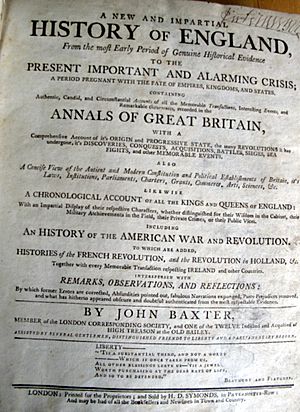John Baxter (political reformer) facts for kids
John Baxter (1756-1845?) was a British writer and a craftsman who worked with silver. He lived in Shoreditch, London, during the late 1700s and early 1800s. He is remembered for being a leader of the London Corresponding Society in 1794. This group worked for political changes in Britain. Baxter was also one of twelve people accused during the important 1794 Treason Trials. In 1796, he wrote and published his own history book called A new and impartial history of England.
Contents
Early Life and Beginnings
John Baxter was born on August 17, 1756. He was christened on September 5, 1756, at St. Leonard's, Shoreditch church. He married Mary Adams on September 2, 1776, at the same church. Baxter usually worked as a silversmith, making things out of silver.
Before he joined the London Corresponding Society, Baxter had a notable incident. He was at a local meeting in Shoreditch. He questioned ideas about people who wanted to make England a republic. Some people at the meeting became upset with him. They accused him of causing trouble. However, the accusations were later dropped. One story from that time says Baxter was "scarcely three feet and a half high." This suggests he might have had dwarfism.
Leading the London Corresponding Society
Baxter became the chairman of the London Corresponding Society in 1793. This happened after the previous chairman, Maurice Margarot, was arrested and sent to Botany Bay in Australia. At this time, Baxter was described as a skilled silversmith living in Shoreditch.
In November 1793, Baxter helped write important messages. These messages were sent to "friends of peace and parliamentary reform" and to the King. They asked for an end to the war against France. He worked on these messages with Thomas Hardy, who was the group's secretary.
In June 1794, Baxter was arrested. He was accused of serious wrongdoing during the 1794 Treason Trials. However, after other people like Thomas Hardy were found not guilty, the authorities did not continue with Baxter's case. He was released in December of that year. While he was in prison, Baxter's wife received payments from the London Corresponding Society.
Forming the Friends of Liberty
In March 1795, John Baxter and a bookseller named Joseph Burks started a new group. They left the London Corresponding Society to form 'The Friends of Liberty'. Baxter became the president of this new group.
In November 1795, Baxter gave a speech. He later published it as Resistance to oppression, the constitutional right of Britons asserted. In his speech, he said that the struggles of poor people were caused by the "Pride and Luxury of the Great." However, he made it clear that he was not asking for violence.
Writing a New History of England
In February 1796, Baxter shared his plans for a new book. It was called A new and impartial history of England. He wrote it himself, with help from "several gentlemen, distinguished friends to liberty." The book was dedicated to the London Corresponding Society and to the people of Britain.
The book was published in weekly parts during 1796 and early 1797. Baxter wanted his history to be different from David Hume's popular history. He wanted to give English people "a perpetual memento of their rights and privileges." Baxter explained his reasons for writing the book in its introduction. He felt it was very important to write it because people in power were taking away people's freedoms. He said they were putting people in prison and trying to harm them for opposing unfair rules.
The first part of the book (up to the year 1689) was mostly a shorter version of Hume's history. But Baxter changed how some important events were explained. These included the Magna Carta and the Glorious Revolution. The rest of the book, covering the Whig supremacy and the American and French Revolutions, was Baxter's own work. It brought the story up to date.
Even though Baxter used a lot of Hume's work, he didn't give him much credit. He only mentioned Hume to criticize his ideas. However, Thomas Jefferson in America tried to get Baxter's book reprinted. Jefferson wanted it to be a "republican" history for American universities, instead of Hume's "Tory" history.
Later Years
For the next twenty years, John Baxter continued to be involved with other political reformers in London. His name appears in official records and reports from government spies. For example, in 1798, he was part of a debating society. In 1799, he was arrested with members of the United Irishmen during a police raid.
He was seen at the funeral of Maurice Margarot in 1815. The next year, he was mentioned in a funny political paper called The polemical fleet. There, he was given the nickname 'Impregnable'. In 1817, he helped organize political discussion groups at a pub called the Mulberry Tree. It is thought that he might be the John Baxter who passed away in Shoreditch in late 1845.


